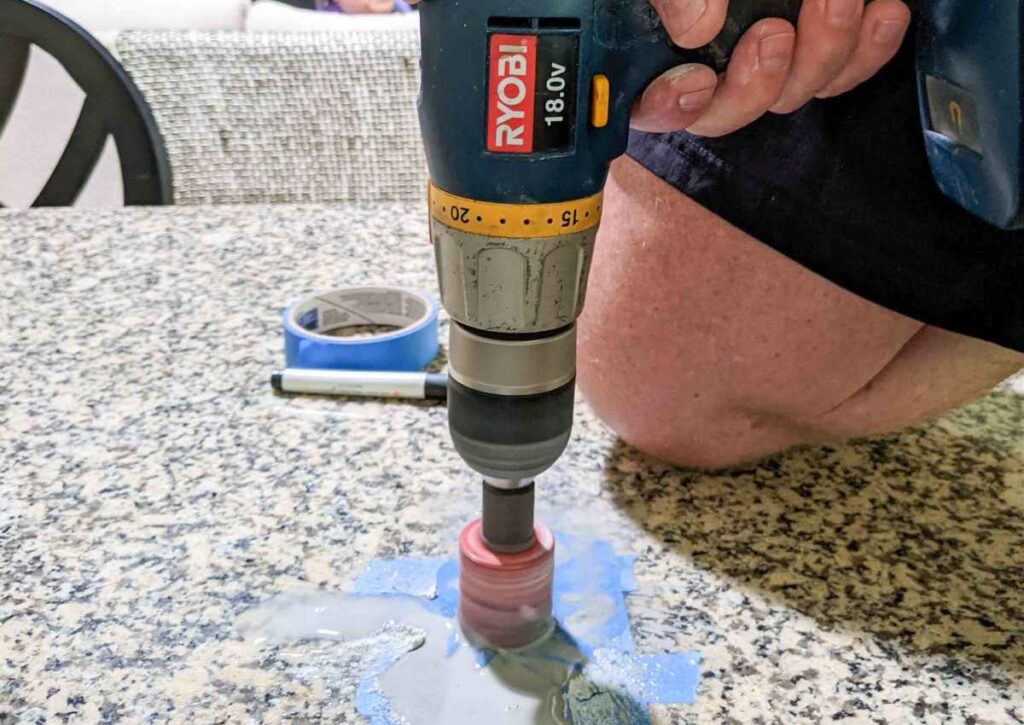Granite is a popular choice for countertops, flooring, and other home decor due to its durability and natural beauty.
However, drilling into granite can be a daunting task for many DIY enthusiasts. With the right tools and techniques, you can easily learn how to drill into granite and complete your home improvement projects with ease.
To drill granite, use a diamond-tipped drill bit and apply water to keep the bit cool. Start with a small hole and gradually increase the size. Avoid applying too much pressure, as this can cause the granite to crack.
In this article, we will guide you through the process of drilling granite, from choosing the right tools to mastering the technique. So let’s get started!
Why Is Drilling Granite Different?
Before we dive into the process of drilling granite, it’s important to understand why it’s different from drilling into other materials.
Granite is an igneous rock, formed from the cooling and solidification of molten magma. It is an extremely hard and dense material, making it difficult to drill through.
Granite has a crystalline structure, which can cause the drill bit to wander or slip off the surface, resulting in an uneven or damaged hole. This is why it’s crucial to use the right tools and techniques when drilling into granite.
Choosing the Right Tools

The first step in mastering the art of drilling granite is choosing the right tools. Here are the essential tools you will need:
- Diamond-tipped drill bit: This is the most important tool for drilling granite. Diamond is the hardest material on earth and is capable of drilling through granite with ease. Make sure to choose a high-quality diamond-tipped drill bit for best results.
- Drill: A standard electric drill with a variable speed setting is ideal for drilling granite. Make sure to use a drill with a side handle for better control and stability.
- Masking tape: This will help prevent the drill bit from slipping on the surface of the granite.
- Water: Drilling into granite produces a lot of heat, which can damage the drill bit. Using water as a lubricant will help keep the drill bit cool and prolong its lifespan.
Preparing the Granite Surface
Before you start drilling, it’s important to prepare the granite surface to ensure a smooth and successful drilling process. Here’s what you need to do:
- Mark the drilling spot: Use a pencil or a marker to mark the spot where you want to drill. This will help guide the drill bit and prevent it from wandering.
- Secure the granite: Place the granite on a stable surface and use clamps to secure it in place. This will prevent the granite from moving or vibrating while drilling.
- Apply masking tape: Place a piece of masking tape over the marked spot. This will not only prevent the drill bit from slipping but also help prevent chipping or cracking of the granite.
Mastering the Technique to drill granite
Now that you have the right tools and have prepared the granite surface, it’s time to master the technique of drilling into granite. Follow these steps for best results:
- Start with a small pilot hole: Use a small drill bit (1/8 inch) to create a pilot hole on the marked spot. This will help guide the diamond-tipped drill bit and prevent it from slipping.
- Use a low speed setting: Set your drill to a low speed setting (around 500 RPM) and start drilling at a 45-degree angle. This will help the drill bit to bite into the granite and prevent it from slipping.
- Keep the drill bit cool: As you drill, make sure to keep the drill bit cool by spraying water on it. This will prevent the drill bit from overheating and prolong its lifespan.
- Increase the speed and angle: Once the pilot hole is created, increase the speed of the drill and gradually increase the angle to 90 degrees. This will help create a smooth and even hole.
- Use light pressure: Do not apply too much pressure while drilling. Let the drill bit do the work and use light pressure to guide it through the granite.
- Remove the masking tape: Once the hole is drilled, remove the masking tape and clean the surface with a damp cloth.
Tips for Drilling Different Types of Granite

Not all granite is created equal, and some types may require different techniques for drilling. Here are some tips for drilling different types of granite:
- Dark-colored granite: Dark-colored granite is denser and harder than light-colored granite. This means you may need to use more water and apply more pressure while drilling.
- Light-colored granite: Light-colored granite is softer and easier to drill through. However, it’s important to use a high-quality diamond-tipped drill bit to prevent chipping or cracking.
- Polished granite: Polished granite has a smooth and shiny surface, which can make it difficult for the drill bit to grip. Use masking tape and start with a small pilot hole to prevent the drill bit from slipping.
- Unpolished granite: Unpolished granite has a rough and uneven surface, which can make it easier for the drill bit to grip. However, it’s important to use a high-quality drill bit to prevent chipping or cracking.
Common Mistakes to Avoid
Drilling into granite can be a challenging task, and even a small mistake can result in a damaged or uneven hole. Here are some common mistakes to avoid:
- Using the wrong drill bit: Using a regular drill bit instead of a diamond-tipped drill bit can result in a damaged drill bit and an uneven hole.
- Not using enough water: Drilling into granite produces a lot of heat, which can damage the drill bit. Make sure to use enough water as a lubricant to keep the drill bit cool.
- Applying too much pressure: Applying too much pressure while drilling can cause the drill bit to slip or break. Use light pressure and let the drill bit do the work.
Conclusion
Drilling into granite may seem like a daunting task, but with the right tools and techniques, it can be easily mastered.
Remember to choose a high-quality diamond-tipped drill bit, prepare the granite surface, and use water as a lubricant to keep the drill bit cool.
With these tips in mind, you can confidently tackle any home improvement project that involves drilling into granite. Happy drilling!
FAQs
What type of drill bit should I use to drill granite
It’s best to use a diamond-tipped drill bit for drilling granite. Diamond bits are designed to cut through the hard surface effectively.
How can I prevent the drill bit from overheating when drilling granite?
To prevent overheating, apply water or a coolant while drilling. This helps to keep the drill bit and granite cool during the drilling process.
Should I use a hammer drill when drilling granite?
Yes, a hammer drill is recommended for drilling granite. It provides the necessary impact force to penetrate the hard stone effectively.
What safety precautions should I take when drilling granite?
Wear safety goggles and a dust mask to protect your eyes and respiratory system from granite dust. Additionally, work in a well-ventilated area to disperse any airborne dust.
Can I drill granite without any prior experience?
Yes, it is possible to drill granite without any prior experience, but it’s recommended to acquire guidance or instructions for safety and best practices.
Also Read
How To Drill Holes Into Plastic | 5 Easy Steps









